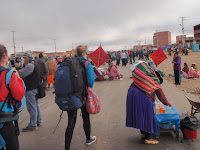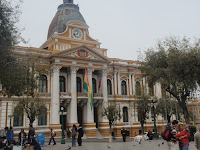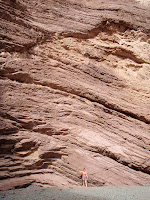Days 22-28
High and Dry in Chile and Bolivia (Countries 4 and 5) - part 2
The next morning we got up early and prepared for our desert crossing. We got a bus up to the Bolivian Border where we met our 4 wheel drive transport ad drivers for the crossing. Apparently the border sometimes randomly is not open and this then entails a 10 hour drive round to the next crossing point, so you can imagine our relief when we saw that the crossing was open.
 |
| Heading up to the Altiplana and the Bolivian Border |
We met our two drivers with their Toyota Landcruisers who promptly disapperead under one of the vehicles and spent about 45 minutes dry-sealing something .... a little concerning. We soon learned however, that every time we stopped they were checking and fixing things! Once they were ready we loaded up the cars with all our main luggage, water, spare fuel etc on the roof and everything else inside. We had to take all our own water, food and toilet roll for our 3 days journey! We even had our own cook called Lily, who was our driver, Pablo's wife. She fed us extremely well for the whole journey which was great. Once we were loaded we set off on dirt tracks through desert terrain that kept changing ...
 |
| Green Lagoon |
 |
| Green Lagoon |
Our first stop was the Green Lagoon at 4600m (15,000ft) - it really was bright green - because of the minerals (high concentration of lead, copper and sulphur) in it and surrounded by snow capped mountains and volcanoes, including Licancabur (5960m, 19,000ft).
 |
| Coloured Lagoon |
Our next stop was our lunch stop at the Coloured Lagoon - a beautiful blue with a natural hot pool in which we relaxed for a while after lunch.
 |
| In the hot pool |
 |
| Better get out of the way .... |
Our last stop for the day was at a place where there was lots of geological activity with steaming vents and bubbling mud pools.

 |
| Sunset from the hostal |
From there we want to out hostal. It was very basic, but was clean and had flushing toilets! Once the sun went down the temperature dropped rapidly and it got really quite cold. I slept in my thermals, a fleece and my socks in a sleeping bag underneath 4 blankets and was comfortably warm!
A few of the team were feeling the effects of altitude and were feeling not very well, quite headachy and absolutely exhausted. The local brew to deal with altitude sickness is Coca Tea which is really quite nice!
Next morning we were up early, loaded the vehicles and were off again. This time our first stop was at the Red Lagoon (4278m), which was very red from the minerals in it. It also had loads of flamingos - not something I expected at that altitude.
 |
| Red Lagoon and Flamingos |
 |
| Red Lagoon |
Our next stop was at the Valley of the Rocks - an area full of enormous rocks that have been hewn by the wind into all sorts of interesting shapes. Goodness knows how they got there, but one can only assume they were fired out of a volcano at some time long in the past!
Our final stop of the day was at a beautiful Blue Lagoon with more flamingos and perfect reflections - stunning!
Throughout the trip it has been very dry - not surprising as it is the Atacama Desert - so there has been very little signs of greenery or plant life, Accordingly we did not see much animal life either. By the lakes there were the flamingos, small dipper type birds and some ducks. On the land all we saw were llamas and vicunas (like smaller, slightly less wooly llamas)!
It is a strange and harsh place, but nonetheless very beautiful.
 |
| Our vehicles and our tracks ... |
Again we packed the vehicles early in the morning and set off into the desert again. This was our final day of the desert crossing.
Our first stop was at a strange place where there was a train 'graveyard'! There were lots of old rusting steam trains apparently abandoned there in the 1950s. Apparently trains used to be the main mode of transporting minerals to the coast for export, but with modernisation, the old trains became redundant and stopped being used.
From there we went onto the Salars de Uyuni - the Salt Flats. This is an area of 12,500m2 of salt flat. it was originally sea and then with geological movements of tectonic plates, it bcame a lake which evaporated and formed the salt flats. Becasue they are perfectly flat and perfectly white and there is nothing to give perspective it is possible to take some wierd and interesting photographs that play tricks with the eyes! (We didn't quite get them all perfectly right.)
Needless to say, they also make salt on the flats - 5000kg per day all dug, dried, prepared and bagged by hand, only bringing in about 1300 Bolivianas (130 pounds) per day! The buildings by the salt flats are also made of salt - salt blocks - the only wood is for door frames and doors and window frames!
When we had finished playing with our cameras, we went to the town on Uyuni - a very strange one-horse town. It felt good however, as it was down at 3600m and the hotel had hot showers!! It was here that we said goodbye to Pablo and Lily - you can see that Bolivians are generally very small and I felt very tall!!
I loved the desert crossing, but it was also good to be back in some form of civilisation!
























































